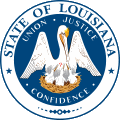 | Find Louisiana State Museum on Facebook |
 | Find Louisiana State Museum on Twitter |
| 2016 Sunset Report |
| OLG & DCRT Strategic Plan 2020-21 through 2024-25 |

- Quality - Louisiana State Library
85% of the users of the State Library indicated that the State Library's services and resources was a good value for the State.Source: The Impact of the Louisiana Department of Culture, Recreation and Tourism on Louisiana's Economy and Quality of Life for Louisiana's Citizens - June 2006
- Louisiana's deep water ports
Did you know that Louisiana's five deep water ports handle more than 457 million tons of U.S. waterborne commerce a year? - Quality - Louisiana State Library
85% of the users of the State Library indicated that the State Library's services and resources was a good value for the State.Source: The Impact of the Louisiana Department of Culture, Recreation and Tourism on Louisiana's Economy and Quality of Life for Louisiana's Citizens - June 2006
- Atchafalaya Heritage Area
The Atchafalaya Heritage Area has been designated by Congress as a National Heritage Area.
- Impact - DCRT Returns Investment Dollars to Louisiana
For every state tax dollar spent by the Department of Culture, Recreation and Tourism, $5.86 is returned to the State Treasury and citizens of Louisiana.Source: The Impact of the Louisiana Department of Culture, Recreation and Tourism on Louisiana's Economy and Quality of Life for Louisiana's Citizens - June 2006
- Impact - Louisiana Office of Tourism Tops Returns on Investment
$13.90 is the return on investment for every dollar spent by the Office of Tourism. Over 175,000 people were directly employed by the Louisiana travel and tourism industry in 2004. In terms of production, $5.9 billion (3.8%) of Louisiana's Gross State Product was directly attributable to expenditures by visitors to LouisianaSource: The Impact of the Louisiana Department of Culture, Recreation and Tourism on Louisiana's Economy and Quality of Life for Louisiana's Citizens - June 2006
- Impact - Supporting the Louisiana Arts
Every dollar in state support for the Arts leverages $7 in earned and contributed revenue. Louisiana's cultural enterprises provide nearly 144,000 jobs for Louisiana citizens, accounting for 7.6% of total employment. Arts has a total economic impact of $934 million in Louisiana.Source: The Impact of the Louisiana Department of Culture, Recreation and Tourism on Louisiana's Economy and Quality of Life for Louisiana's Citizens - June 2006
- Impact - Visitors Generate State Revenue
In terms of tax revenues, visitor spending accounted for $677 million of 2004 Louisiana revenues, or 8.3% of the total 2004 State Budget.Source: The Impact of the Louisiana Department of Culture, Recreation and Tourism on Louisiana's Economy and Quality of Life for Louisiana's Citizens - June 2006
- Quality - Louisiana State Museums
95% of State Museum's visitors strongly agreed or agreed that the State Museum was an educational experience and has expanded their awareness of Louisiana's cultural history.Source: The Impact of the Louisiana Department of Culture, Recreation and Tourism on Louisiana's Economy and Quality of Life for Louisiana's Citizens - June 2006
- Quality - Historic Preservation and the Arts
78-80% of Louisiana residents believe that historic preservation and arts are important and should be high priorities.Source: The Impact of the Louisiana Department of Culture, Recreation and Tourism on Louisiana's Economy and Quality of Life for Louisiana's Citizens - June 2006
- Impact - Louisiana Serve Program
The Louisiana Serve Program in the Office of Lieutenant Governor returns 2.8 million in non-state revenue to Louisiana. - Impact - Louisiana State Museum
The Office of State Museum returns $6.99 for every tax dollar spent.Source: The Impact of the Louisiana Department of Culture, Recreation and Tourism on Louisiana's Economy and Quality of Life for Louisiana's Citizens - June 2006
- Impact - Louisiana State Parks
Visitor spending at Louisiana State Parks returns $3.23 in state taxes for every dollar spend on operating and maintaining all our beautiful parks. Out-of-state visitors to Louisiana State Parks spent almost $12 million in Louisiana and produced an economic impact of over $24 million. Louisiana residents spent another $29.2 million while visiting the parks.Source: The Impact of the Louisiana Department of Culture, Recreation and Tourism on Louisiana's Economy and Quality of Life for Louisiana's Citizens - June 2006
- Impact - Scenic Byways Program
The Scenic Byways program leverages $1.56 for every dollar spent by the program.Source: The Impact of the Louisiana Department of Culture, Recreation and Tourism on Louisiana's Economy and Quality of Life for Louisiana's Citizens - June 2006
- Louisiana State Parks and the National Register
Thirteen Louisiana State Parks sites are on the National Register of Historic Places. They include:
• Audubon State Historic Site
• Centenary State Historic Site
• Fort Pike State Historic Site
• Fort Jesup State Historic Site
• Longfellow-Evangeline State Historic Site
• Mansfield State Historic Site
• Marksville State Historic Site
• Plaquemine Lock State Historic Site
• Port Hudson State Historic Site
• Poverty Point State Historic Site
• Otis House at Fairview-Riverside State Park
• Rosedown Plantation State Historic Site
• Winter Quarters State Historic Site - Louisiana State Parks Visitation
Nearly two million people visited a Louisiana State Park last year. - Louisiana State Parks Grow and Renew
The Louisiana Office of State Parks has spent nearly $80 million in major construction projects since 2004, providing two brand-new parks and a new historic site, adding cabins and campsites to existing parks and building visitor center at one park, the preservation area and three historic sites. - Louisiana State Parks Wireless Internet
The Louisiana Office of State Parks provides free wireless internet access at all 20 recreational parks. Extensive coverage areas include most cabins, RV slips and campsites. - Louisiana State Parks Online Reservations
You can now make online reservations for cabins, campsites, lodges and group camps – at www.ReserveLaStateParks.com - Louisiana State Parks Honors National Parks Service Senior Pass Program
Visitors who hold an America the Beautiful Senior or Access Pass, and whose home State Park system honor the America the Beautiful passes for camping discounts, are entitled to a 50% reduction on camping fees at Louisiana State Parks. Certain restrictions apply, see State Parks' fees & facilities page for more information. - Louisiana State Parks Draw Media Attention
Louisiana State Parks sites have been featured in movie and television releases including "True Detective," CBS’ "Zoo," and "NCIS: New Orleans," "G.I. Joe: Retaliation," "Selfless," "Devil’s Due," and commercials for Popeyes and Toyota. - Capitol Park Welcome Center
The main meeting room in the Capitol Park Welcome Center is named after Margaret Taylor, wife of U.S. President Zachary Taylor. The couple resided in a small house near the present day location of Capitol Park until Taylor was elected to the Presidency.
| Table of Contents | Early Aviation in LA | The Williams Family | Jimmie and Walter Wedell | Patterson Airport | Selected Bibliography |
Delta , Eastern, and American in Louisiana
In the late 1910s entomologist Dr. Bert R. Coad at the United States Department of Agriculture field laboratory at Tallulah, Louisiana, sought ways to eliminate the boll weevil, a tiny insect that annually destroyed large portions of the southern cotton crop. He experimented with dry powder insecticides, including lead arsenate and calcium arsenate. In search of a method to speed up the process of application, he soon realized the value of aerial crop-dusting.
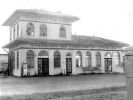 Tallulah Airport |
Through his work Coad came into contact with C. E. Woolman, a district supervisor for the Louisiana State University agricultural extension service. Woolman, an aviation enthusiast, had attended the world's first aviation meet in Rheims, France, in 1909. Coad and Woolman became acquainted with George B. Post, vice president of the Huff Daland Company, which created a crop-dusting division in 1924. The following year the company hired Woolman and shifted its operations from Macon, Georgia, to Monroe, Louisiana.
Huff Daland was seasonally successful, suffering only from the expected drop in business after the cotton harvest. Seeking relief from these annual dips in revenue, the company began operations in Peru, taking advantage of the climate reversal. Woolman was instrumental in Huff Daland's expansion there as it established passenger, mail, and freight services in 1928.
C. E. Woolman returned to the United States only to find Wall Street financiers poised to liquidate Huff Daland Dusters. Partly through his contacts among Monroe businessmen, Woolman raised enough capital to purchase Huff Daland's assets and start his own aviation enterprise, Delta Air Service, a name chosen to reflect its Mississippi Delta base. On June 17, 1929, the first passenger service departed from Dallas’s Love Field to Jackson, Mississippi, with stops at Shreveport and Monroe.
Delta Air Service had little chance of obtaining a mail contract, a crucial building block in the aviation industry during this period. Postmaster General Walter Folger Brown made it clear that he was going to construct a United States airline system with routes that, in his words, "went from somewhere to somewhere." Apparently, he did not believe that a route from Dallas to Jackson, via Shreveport and Monroe, fit this description.
Undeterred, Woolman pressed ahead. He first extended Delta's route at both ends, to Fort Worth and to Birmingham, and in June 1930 added Atlanta, the largest and fastest-growing city in the southeastern United States. It was here that Delta collided with Eastern Air Transport’s (EAT) New York–Miami route.
Eastern was established in 1929 when its parent company, Pitcairn Aviation, decided to separate its manufacturing and airline divisions. Eastern and Woolman agreed upon a coordinated plan whereby EAT would submit a bid for a mail route from Atlanta to New Orleans, which Delta would then fly under subcontract. Unfortunately for Woolman and Delta Air Service, the postmaster general held the final authority to award mail contracts, and he had other ideas.
To some extent, Postmaster General Brown was farsighted. Dismayed by the railroads' failure to fashion a cohesive coast-to-coast route (Canada had two), Brown was determined that airmail would avoid the labyrinthine course set by the railroads. He had a clear vision of a sensible air network: three transcontinental lines linked with several north-south lines at the coasts, along the Mississippi, and down the Rocky Mountains, plus a few supplementary crossfeeds.
He therefore resolved that, instead of the almost entirely localized companies that resulted from the first Air Mail Act (the Kelly Act) of 1925, he would establish a structure for a coordinated nationwide airmail service. In April 1930 he persuaded Congress to pass an amendment to the Kelly Act, known as the McNary-Watres Act. This law changed the basis of airmail payments from weight carried to space offered; laid down strict qualifications for bidders; and permitted extension clauses to existing routes, covered by the Commercial Air Mail (CAM) contracts. Under this new legislation, C. E. Woolman and Delta Air Service didn’t have a prayer.
The new system of payments by space offered favored the big airlines, which had the larger equipment. The qualifications included two years of operating experience, including night flying, which Delta lacked. Further, the postmaster general awarded contracts to large, well-capitalized corporations that could pour heavy investment into buying aircraft, establishing ground support, and setting up commercial organizations on a large scale. On September 16, 1930, Walter Brown awarded the southern transcontinental airmail contract to American Airways.
Delta Air Service suspended operations and sold all its equipment to Southern Air Fast Express (SAFEway), also a victim of the rapidly expanding American. Woolman soon repurchased equipment from SAFEway, however, and resumed crop-dusting as the Delta Air Corporation. In 1931 Woolman hired Bert Coad, who ran Delta crop-dusting division until it was discontinued in 1966.
A few years later, President Franklin D. Roosevelt stepped in to change the contractual system of route awards and mail. In a far-reaching piece of legislation, the Air Mail Act of 1934, known as the Black-McKellar Act, removed most of the inequities of McNary-Watres. C. E. Woolman, still dusting in Louisiana, seized his chance and formally re-entered the airline business. The Delta Air Corporation made the lowest bid for the new Route 24 and received the contract. With only a few crop-dusters in his stable, Woolman purchased six Stinson "T" tri-motors from American Airlines, (formerly American Airways), which was moving up to larger Curtiss and Douglas equipment. Delta began airmail service on July 4, 1934, between Dallas and Monroe, via Tyler, Texas, and Shreveport. A second route connected Monroe to Atlanta through Birmingham, and a third tied Atlanta to Charleston, South Carolina.
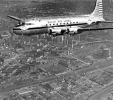 Delta in Flight. | 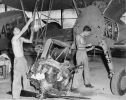 Delta mechanics at work. |
Brigadier General Claire L. Chennault
Born in Commerce, Texas, in 1890, Chennault was reared on a farm near Waterproof, Louisiana. As a youth he was encouraged to be self-reliant, and he grew to be combative, defiant, quick to take offense, and determined to rank first.
He entered Louisiana State University at the age of fourteen and later became a teacher. He joined the United States Army in April 1917 as America entered World War I. Chennault became a student of military aviation and developed a reputation as a maverick due to his unconventional views regarding tactical deployment of wartime airpower. He retired as a captain in 1937, ostensibly due to a hearing loss he suffered as a result of many years in open cockpits.
Chennault’s writings on combat airpower drew the attention of General Chiang Kai-shek, whose Chinese forces had been ravaged by four years of Japanese conflict. The general invited Chennault to China to advise him in the rebuilding of the Chinese air force. Through 1940, Chennault busily trained pilots, but they were no match against the superior numbers and equipment of the invaders.
Chennault enlisted support for the Chinese government and was able to procure 100 Curtiss P-40 Warhawks originally intended for the Royal Air Force. A small group of volunteers, about 110 pilots and 150 support personnel, were recruited from the United States services. This fledgling force, an American volunteer group known as the Flying Tigers, initially operated in China under the guise of a commercial air transport company, but soon confronted the Japanese in open battle. The group flew its first offensive mission on December 10, 1941. During the next eight months, the Flying Tigers achieved the remarkable combat record of 299 Japanese aircraft destroyed at the expense of only 4 American pilots.
Chennault was recalled to active duty in 1942 with the rank of brigadier general and placed at the head of the China Air Task Force, later the Fourteenth Air Force. He retired as a major general in 1945. In 1958 Chennault met an enemy he could not defeat—cancer. He died July 27, 1958, in New Orleans shortly after receiving his third star. He was buried in Arlington National Cemetery with full military honors.
Transatlantic Helicopter Flight
Donald Maurras was born in Algiers, Louisiana, in 1925. Upon graduation from Behrman High School, he enlisted in the United States Army Air Corps. Maurras served in the Korean War and later as part of a helicopter unit supporting CIA operations in Laos during the Vietnam War. It was as part of this unit that Maurras and several of his colleagues developed an idea for in-flight helicopter refueling. The C-130 was chosen due to its relative airspeed and its ability to carry tremendous amounts of excess fuel weight.
 Donald Maurras |
After his tour in Vietnam, Major Maurras was assigned to rescue school at Eglin Air Force Base, near Fort Walton Beach, Florida, where he was able to perfect the system for aerial refueling. An air show scheduled for Paris in 1967 provided the perfect test opportunity. Two Sikorsky HH-3E helicopters, also known as "Jolly Green Giants," which were scheduled to be shipped to Paris for the air show, were reassigned to Maurras and Major Herbert Zehnder to attempt the first nonstop helicopter flight across the Atlantic Ocean.
The 4,157-mile voyage was successfully completed on June 1, 1967, after 30 hours and 48 minutes of flight time. Two Hercules HC-130 tankers refueled each HH-3E a total of nine times. Altitudes ranged from 1,000 to 9,000 feet, and the average speed was 135 miles per hour. After the air show, both aircraft were assigned to active rescue duty in Vietnam.
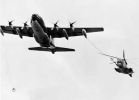 Helicopter refueling in air. | 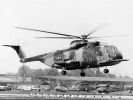 Landing in Paris |  Congratulations from the Sikorsky's |
Patterson Airport
With the demise of the Wedell-Williams Corporation, the future of the Patterson Airport became uncertain. As was the case with many business ventures throughout the nation, World War II would prove to be the savior of the airfield at this crucial juncture. As it became more apparent that the United States would be involved in the war, a group of local aviators, including former St. Mary Parish Sheriff Chester Baudoin and L. J. Gros, started the Civilian Pilot Training Program (CPT) on the grounds of the Patterson Airport. Among the early CPT trainees was future Brigadier General Wiltz Segura of New Iberia. The exercises revitalized the airport. After the United States entered World War II in December 1941, the CPT became even more important.
Local officials expected that the federal government would use the Patterson Airport for the military defense of the Gulf Coast. To facilitate this use, St. Mary Parish purchased additional land adjacent to the airport so that it could be expanded and improved. Before the project could get under way, however, military authorities determined that the Gulf area was no longer vulnerable.
In 1947 the state of Louisiana began to develop the airport , initially constructing a small shop for crop-duster repair. Another hangar was added in 1953, a caretaker’s residence in 1955, and a paved runway the following year. In 1969 new landing lights, a runway extension to 5,400 feet, and a 4,500-foot lighted seaplane seaway significantly enhanced the airport's utility.
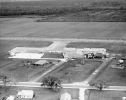 Aerial View of Patterson Airport |
Perry Flying Center was formed in early 1983 by M. C. Perry, Kenneth Perry, and Joycelyn Landry Perry, who purchased the assets of Hudson Air. Located at the Harry P. Williams Airport in Patterson, Louisiana, the airport serves St. Mary Parish and the central Louisiana Gulf Coast.
In the mid-1980s the oilfield-based economy in south Louisiana collapsed, and Perry lost much of its business. As a result, Perry diversified its operations with the construction of office space and bunkrooms in the main hangar for the use of independent helicopter operators. Perry also began promoting aviation events, including the 1987 and 1989 Patterson Airshows and the 1987, 1988, and 1989 Patterson Mardi Gras Parachute Jumpfests. With the mid-1990s rebound of the oil industry, Perry once again made the airport the primary departure point for offshore workers.

